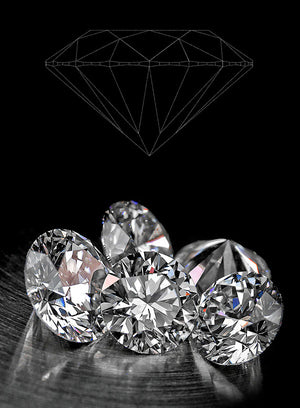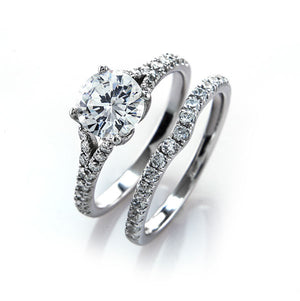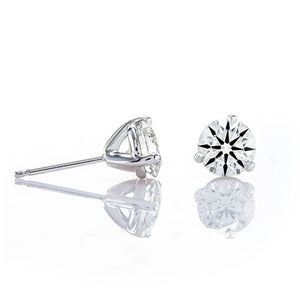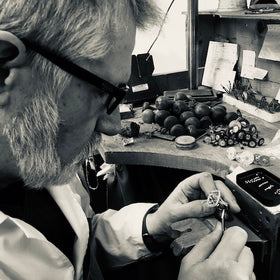
Lab Diamond Benefits: From Quality to Value, & Beyond
One of the biggest challenges consumers face when buying a diamond—online or in a traditional brick-and-mortar jewelry store—is accurately ascertaining the quality of the diamonds they are considering.
When buying a diamond, you want to be certain you’re getting a top-performing stone of the highest quality. For many people, this means choosing a lab grown diamond. However, many people are still unaware of exactly what lab grown diamonds are, their benefits, and other important considerations.
The truth is, lab grown diamonds have many benefits, and we’re here to share them with you. Read on to learn more about lab grown diamonds, why you should choose them, and where they can be used.
What are Lab Grown Diamonds?
A lab-grown diamond is a gem identical in chemical composition to a mined diamond. The difference is, lab-created diamonds are grown in a laboratory environment.
In contrast, natural diamonds are mined from the earth. Lab-grown diamonds are “real” diamonds, but they are grown in a sustainable manner.
Through the CVD method, lab grown diamonds are made by Carbon Vapor Deposition. The interaction of different chemical components creates the CVD lab grown diamond by carbon layering itself onto a diamond seed and growing into a diamond.
The HPHT method makes lab grown diamonds with a High Temperature and High-Pressure process. Carbon melts around the seed by heating and applying high pressure to a diamond seed, forming an HPHT lab diamond.
Why You Should Choose a Lab Diamond
There are many benefits of lab created diamonds when compared to earth-grown diamonds. If you find yourself trying to decide between the two, here is a list of several reasons in favor of a lab grown diamond.
1. Amazing Quality
Because of their growth methods, lab grown diamonds don’t contain the same inclusions as earth-grown diamonds. Lab grown diamonds have high-quality color, cut, clarity, and sparkle - they’re nearly flawless.
At BGD, the CVD process we follow grows the lab diamond in a single cycle, which creates amazing transparency and brightness in the diamond. We also don’t use a post-growth treatment that others use to enhance the diamonds. Our gems are great on their own.
2. They’re Real Diamonds
Regardless of what you might’ve heard, lab grown diamonds are real diamonds.
To the naked eye, it’s impossible to tell the difference between an earth-grown diamond and a lab grown diamond.
3. Better Value
Because they are grown in a lab and are less rare, lab grown diamonds are sold at a better price point. This means you can stay within budget and get a significantly larger stone.
And considering we have many shapes and colors available, and our diamonds are the most perfectly cut lab grown diamonds in the world, you can get an amazing diamond for great value.
4. They are GIA Certified
For many years, diamond grading reports were issued by top-tier gemological laboratories, such as the American Gem Society Laboratory (AGSL) and the Gemological Institute of America (GIA) to provide consumers with a resource they can use to verify the quality of a diamond.
Recently, GIA acquired AGS Laboratories: As such, GIA now owns AGS lab’s cut grade system. We will talk about this in more depth in a moment.
5. Perfect Hearts and Arrows
Our diamonds contain perfect hearts and arrows. We cut our diamonds with a patented process to maximize light performance and create a perfect sparkle - every time.
Hearts and arrows patterns are used in round, cushion, quadex and oval shaped diamonds. For other shapes, we still use our patented process to create a stunning stone with amazing performance.
6. Patented cutting process
In addition to our perfect hearts and arrows patterns, all other diamonds we offer are also cut with a patented process that results in a stunning stone with amazing performance. We use advanced technology to map out each diamond's unique features, allowing us to identify the best cuts for maximum beauty.
Understanding GIA Certifications Grading Reports
These certifications give peace of mind as purchasing a diamond is an emotional and financial investment. Unfortunately, one of the pitfalls of diamond grading reports is they can create a false sense of security.
This is because the diamond is accompanied by a report indicating the diamond has an overall cut grade which is the highest available…from that particular gemological laboratory.
Recently, the Gemological Institute of America (GIA) and the American Gem Society Laboratories (AGS Labs) have merged, with AGS integrating its research and development team, intellectual property, and facility into GIA. Now, GIA owns AGS’s cut grade system.
As part of the partnership, GIA has introduced the AGS Ideal Report by GIA, a digital supplement to certain GIA diamond reports. The report utilizes the AGS Light Performance system to assess a diamond's beauty based on:
- Brightness
- Fire
- Contrast
- Overall appearance
Example #1 Round Brilliant Cut Diamond from Another Diamond Company
For instance, consider this snippet of a diamond grading report issued by the GIA for a round brilliant cut diamond—they gave it an overall cut grade of GIA Excellent. A client sent it to us to find out how this diamond compared to a Brian Gavin Signature round hearts and arrows (natural) diamond of the same carat weight, color, and clarity.
According to the GIA, the diamond referenced above has a total depth of 59.2%. It also has a table diameter of 60% with a crown angle of 32.5 degrees. The crown angle is offset by a pavilion angle of 41.0 degrees with a medium to slightly thick, faceted girdle, and no culet.
The reality is, the proportions of this diamond fall along the very outer edge of the range designated for the original AGS’s zero ideal cut proportions rating. Conversely, the proportions of the Brian Gavin Signature round diamonds we produce fall within the center of the range designated for the AGS zero ideal cut rating, as well as, confirm with the strict parameters of Brian Gavin’s patent for maximizing light performance.
This means it isn't possible to look at the proportions of a diamond as provided on a diamond grading report and determine whether the diamond will likely exhibit a crisp and complete pattern of hearts and arrows.
The only way to verify the existence of a hearts and arrows pattern within a diamond is to look at the diamond through a Hearts & Arrows Scope. Then, the consistency of the pattern must be graded if it happens to be present.
Example #2: Brian Gavin Signature Round Diamond
For instance, this 1.233 carat, G-color, SI-2 clarity, Brian Gavin Signature round diamond (natural) has a total depth of 61.4%. It also has a table diameter of 57% and a crown angle of 34.7 degrees. The crown angle is offset by a pavilion angle of 40.8 degrees with a thin to medium faceted girdle and a pointed culet.
In this case, we’re talking about a difference in proportions as distinct as night and day!
Yes, the proportions of a round brilliant cut diamond impact the appearance of a hearts and arrows pattern when present in a diamond. However, the proportions are only one piece of the puzzle that creates the hearts and arrows patterns that appear in every Brian Gavin Signature round diamond.
Where Can Lab Diamonds Be Used?
You might be wondering if there are special settings for lab grown diamonds or where they can be used.
The truth is, a lab grown diamond can be used anywhere an earth-grown diamond can!
Whether you’re shopping for a diamond for an engagement ring, diamond earrings or a bracelet, a lab grown diamond is an option you’ll certainly want to consider.
Ready to Shop for Lab Grown Diamonds?
At Brian Gavin Diamonds, we pride ourselves on creating top-performing lab grown diamonds with our Premium and Deluxe Collections that sparkle brilliantly and beautifully.
Investing in a lab grown diamond ensures you’ll have a diamond ranking in the top spots of Brian Gavin’s five C’s: cut/shape, clarity, carat, color, and cut/performance. At Brian Gavin, we recognize a fifth C for cut/performance. It’s not all about shape - it’s about how that diamond performs.















